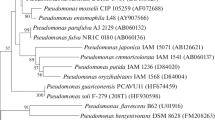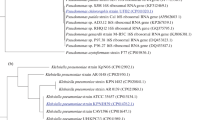Abstract
A bacterium that uses 2-chloroethanol as sole energy and carbon source coupled to denitrification was isolated from 1,2-dichloroethane-contaminated soil. Its 16 S rDNA sequence showed 98% similarity with the type strain of Pseudomonas stutzeri (DSM 5190) and the isolate was tentatively identified as Pseudomonas stutzeri strain JJ. Strain JJ oxidized 2-chloroethanol completely to CO2 with NO3 − or O2 as electron acceptor, with a preference for O2 if supplied in combination. Optimum growth on 2-chloroethanol with nitrate occurred at 30 °C with a µ max of 0.14 h−1 and a yield of 4.4 g protein per mol 2-chloroethanol metabolized. Under aerobic conditions, the µ max was 0.31 h−1. NO2 − also served as electron acceptor, but reduction of Fe(OH)3, MnO2, SO4 2−, fumarate or ClO3 − was not observed. Another chlorinated compound used as sole energy and carbon source under aerobic and denitrifying conditions was chloroacetate. Various different bacterial strains, including some closely related Pseudomonas stutzeri strains, were tested for their ability to grow on 2-chloroethanol as sole energy and carbon source under aerobic and denitrifying conditions, respectively. Only three strains, Pseudomonas stutzeri strain LMD 76.42, Pseudomonas putida US2 and Xanthobacter autotrophicus GJ10, grew aerobically on 2-chloroethanol. This is the first report of oxidation of 2-chloroethanol under denitrifying conditions by a pure bacterial culture.

Similar content being viewed by others
References
Baggi G, Barbieri P, Galli E, Tollari S (1987) Isolation of a Pseudomonas stutzeri strain that degrades o-xylene. Appl Environ Microbiol 53:2129–2132
Bennasar A, Rossello MR, Lalucat J, Moore ERB (1996) 16S rRNA gene sequence analysis relative to genomovars of Pseudomonas stutzeri and proposal of Pseudomonas balearica sp. nov. Int J Syst Bacteriol 46:200–205
Blake CK, Hegeman GD (1987) Plasmid pCBI carries genes for anaerobic benzoate catabolism in Alcaligenes xylosoxidans subsp. denitrificans PN-1. J Bacteriol 169:4878–4883
Brosius J, Palmer JL, Kennedy JP, Noller HF (1978) Complete nucleotide sequence of a 16S ribosomsal RNA gene from Escherichia coli. Proc Natl Acad Sci USA 75:4801–4805
Çetin ET, Töreci K, Ang Ö (1965) Encapsulated Pseudomonas aeruginosa (Pseudomonas aeruginosa mucosus) strains. J Bacteriol 89:1432–1433
Cox EE, Major D, Edwards E (2000) Natural attenuation of 1,2-dichloroethane in groundwater at a chemical manufacturing facility. In: Wickramanayake GB, Gavaskar AR, Alleman BC, Magar VS (eds) The Second International Conference on Remediation of Chlorinated and Recalcitrant Compounds. Batelle, Monterey, California
Criddle CS, Dewitt JT, D. G-G, McCarty PL (1990) Transformation of carbon tetrachloride by Pseudomonas sp. strain KC under denitrification conditions. Appl Environ Microbiol 56:3240–3246
Dijk JA, de Bont JAM, Lu X, Becker PM, Bosma TNP, Rijnaarts HHM, Gerritse J (2000) Anaerobic oxidation of (chlorinated) hydrocarbons. In: Wickramanayake GB, Gavaskar AR, Alleman BC, Magar VS (eds) The Second International Conference on Remediation of Chlorinated and Recalcitrant Compounds. Batelle, Monterey, California
Duarte GF, Soares Rosado A, Seldin L, Keijzer-Wolters AC, van Elsas JD (1998) Extraction of ribosomal RNA and genomic DNA from soil for studying the diversity of the indigenous bacterial community. J Microbiol Meth 32:21–29
Gerritse J, van der Woude BJ, Gottschal JC (1992) Specific removal of chlorine from the ortho-position of halogenated benzoic acids by reductive dechlorination in anaerobic enrichment cultures. FEMS Microbiol Lett 79:273–280
Gerritse J, Borger A, van Heiningen E, Rijnaarts HHM, Bosma TNP, Taat J, van Winden B, Dijk JA, de Bont JAM (1999) Assesment and monitoring of 1,2-dichloroethane dechlorination. In: Leeson A, Alleman BC (eds) Engineered approaches for in situ bioremediation of chlorinated solvent contamination. Batelle, Columbus, Ohio, pp 73–80
Hage JC, Hartmans S (1999) Monooxygenase-mediated 1,2-dichloroethane degradation by Pseudomonas sp. strain DCA1. Appl Environ Microbiol 65:2466–2470
Hantke J (2000) Molekularbiologische Analyse der mikrobiellen Zusammensetzung anaerober, Dioxine dechlorierender Mischkulturen. PhD thesis, Martin-Luther University Halle.
Heijthuisen JHFG, Hansen TA (1986) Interspecies hydrogen transfer in co-cultures of methanol utilizing acidogens and sulfate-reducing or methanogenic bacteria. FEMS Microbiol Ecol 38:57–64
Heuer H, Hartung K, Wieland G, Kramer I, Smalla K (1999) Polynucleotide probes that target a hypervariable region of 16S rRNA genes to identify bacterial isolates corresponding to bands of community fingerprints. Appl Environ Microbiol 65:1045–1049
Janssen DB, Scheper A, Witholt B (1984) Biodegradation of 2-chloroethanol and 1,2-dichloroethane by pure bacterial cultures. In: Houwink EH, van der Meer RR (eds) Innovations in biotechnology. Progress in industrial microbiology, vol 20. Elsevier Biomedical, Amsterdam, pp 169–178
Janssen DB, Scheper A, Dijkhuizen L, Witholt B (1985) Degradation of halogenated aliphatic compounds by Xanthobacter autotrophicus GJ10. Appl Environ Microbiol 49:673–677
Kodoma T, Shimada K, Mori T (1969) Studies on anaerobic biphasic growth of a denitrifying bacterium, Pseudomonas stutzeri. Plant Cell Physiol 10:855–865
Körner H, Zumft WG (1989) Expression of denitrification enzymes in response to the dissolved oxygen level and respiratory substrate in continuous culture of Pseudomonas stutzeri. Appl Environ Microbiol 55:1670–1676
Lovley DR, Phillips EJP (1986) Organic matter mineralization with reduction of ferric iron in anaerobic sediments. Appl Environ Microbiol 51:683–689
Lovley DR, Phillips EJP (1988) Novel mode of microbial energy metabolism: organic carbon oxidation coupled to dissimilatory reduction of iron or manganese. Appl Environ Microbiol 54:1472–1480
Lowry OH, Rosebrough NJ, Farr AL, Randall RJ (1951) Protein measurements with the Folin phenol reagent. J Biol Chem 193:265–275
McCann J, Simmon V, Streitwieser D, Ames BN (1975) Mutagenicity of chloroacetaldehyde, a possible metabolic product of 1,2-dichloroethane (ethylene chloride), chloroethanol (ethylene chlorohydrine), vinyl chloride and cyclosphosphamide. Proc Natl Acad Sci USA 72:3190–3192
Middelhoven WJ, Bakker CM (1982) Degradation of caffeine by immobilized cells of Pseudomonas putida strain C 3024. European J Appl Microbiol Biotechnol 15:214–217
Murray JW (1974) The surface chemistry of hydrous manganese oxide. J Colloid Interface Sci 46:357–371
Muyzer G, Teske A, Wirsen CO, Jannasch HW (1995) Phylogenetic relationship of Thiomicrospira species and their identification in deep-sea hydrothermal vent samples by denaturing gradient gel electrophoresis of 16S rDNA fragments. Arch Microbiol 164:165–172
Palleroni NJ, Doudoroff M, Stanier RY, Solánes RE, Mandel M (1970) Taxonomy of the aerobic pseudomonads, the properties of the Pseudomonas stutzeri group. J Gen Microbiol 60:215–231
Pearson WR (1990) Rapid and sensitive sequence comparison with FASTAP and FASTA. Methods Enzymol 183:63–98
Poelarends GJ, van Hylckama Vlieg JET, Marchesi JR, Freitas Dos Santos LM, Janssen DB (1999) Degradation of 1,2-dibromoethane by Mycobacterium sp. strain GP1. J Bacteriol 181:2050–2058
Ralebitso TK, Röling WFM, Braster M, Senior E, van Verselveld HW (2001) 16S rDNA-based characterisation of BTX-catabolizing microbial associations isolated from a South African sandy soil. Biodegradation 11:351–357
Richterich R (1965) Klinische Chemie. Akademische Verlaggesellschaft, Frankfurt
Sambrook J, Fritsch EF, Maniatis T (1989) Molecular cloning: a laboratory manual, 2nd edn. Cold Spring Harbor Laboratory, Cold Spring Harbor, New York
Sijderius R. (1946). PhD thesis, University of Amsterdam
Skerman VBD, McGowan V, Sneath PHA (1980) Approved lists of bacterial names. Int J Syst Bacteriol 30:225–420
Strotmann UJ, Pentenga M, Janssen DB (1990) Degradation of 2-chloroethanol by wild type and mutants of Pseudomonas putida US2. Arch Microbiol 154:294–300
Stucki G, Brunner W, Staub D, Leisinger T (1981) Microbial degradation of chlorinated C1 and C2 hydrocarbons. In: Leisinger T, Cook AM, Hütter R, Nüesch J (eds) Microbial degradation of xenobiotics and recalcitrant compounds. Academic, London, pp 131–137
Van den Wijngaard AJ, van der Kamp KWHJ, van der Ploeg J, Pries F, Kazemier B, Janssen DB (1992) Degradation of 1,2-dichloroethane by Ancylobacter aquaticus and other facultative methylotrophs. Appl Environ Microbiol 58:976–983
Van der Meer JR, Roelofsen W, Schraa G, Zehnder JB (1987) Degradation of low concentrations of dichlorobenzenes and 1,2,4-trichlorobenzene by Pseudomonas sp. strain P51 in nonsterile soil columns. FEMS Microbiol Ecol 45:333–341
Weisburg WG, Barns SM, Pelletier DA, Lane DJ (1991) 16S ribosomal DNA amplification for phylogenetic study. J Bacteriol 173:697–703
Xu B, Enfors SO (1996) Influence of nitrate starvation on nitrite accumulation during denitrification by Pseudomonas stutzeri. Appl Microbiol Biotechnol 45:229–235
Acknowledgements
We thank Harald Ruijssenaars (Hercules European Research Center) and Hans Visser (Wageningen University) for help with cloning the 16S rDNA. We also thank Dick B. Janssen, who kindly provided bacterial strains. The research described in this paper was supported by and carried out at the Research Centre on Soil, Sediment and Groundwater Management and Remediation WUR/TNO.
Author information
Authors and Affiliations
Corresponding author
Rights and permissions
About this article
Cite this article
Dijk, J.A., Stams, A.J.M., Schraa, G. et al. Anaerobic oxidation of 2-chloroethanol under denitrifying conditions by Pseudomonas stutzeri strain JJ. Appl Microbiol Biotechnol 63, 68–74 (2003). https://doi.org/10.1007/s00253-003-1346-z
Received:
Revised:
Accepted:
Published:
Issue Date:
DOI: https://doi.org/10.1007/s00253-003-1346-z




